
Mount Vesuvius is a somma–stratovolcano located on the Gulf of Naples in Campania, Italy, about 9 km (5.6 mi) east of Naples and a short distance from the shore. It is one of several volcanoes forming the Campanian volcanic arc. Vesuvius consists of a large cone partially encircled by the steep rim of a summit caldera, resulting from the collapse of an earlier, much higher structure.

Ostia Antica is an ancient Roman city and the port of Rome located at the mouth of the Tiber. It is near modern Ostia, 25 km (16 mi) southwest of Rome. Due to silting and the invasion of sand, the site now lies 3 km (2 mi) from the sea. The name Ostia derives from Latin os 'mouth'.
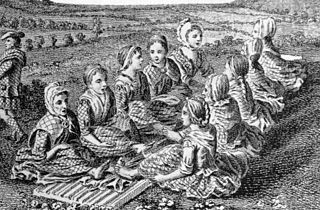
Fulling, also known as tucking or walking, is a step in woollen clothmaking which involves the cleansing of woven cloth to eliminate (lanolin) oils, dirt, and other impurities, and to make it shrink by friction and pressure. The work delivers a smooth, tightly finished fabric that is insulating and water-repellent. Well-known examples are duffel cloth, first produced in Flanders in the 14th century, and loden, produced in Austria from the 16th century on.
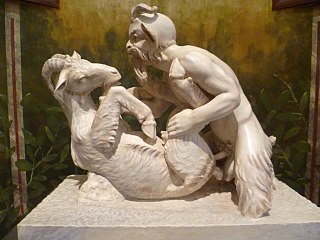
Erotic art in Pompeii and Herculaneum has been both exhibited as art and censored as pornography. The Roman cities around the bay of Naples were destroyed by the eruption of Mount Vesuvius in 79 AD, thereby preserving their buildings and artefacts until extensive archaeological excavations began in the 18th century. These digs revealed the cities to be rich in erotic artefacts such as statues, frescoes, and household items decorated with sexual themes.
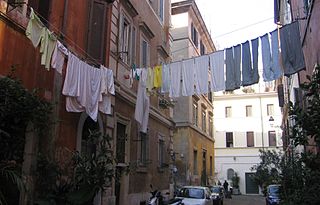
Laundry is the washing of clothing and other textiles, and, more broadly, their drying and ironing as well. Laundry has been part of history since humans began to wear clothes, so the methods by which different cultures have dealt with this universal human need are of interest to several branches of scholarship.

Pompeii: The Last Day is a 2003 dramatized documentary that tells of the eruption of Mount Vesuvius towards the end of August 79 CE. This eruption covered the ancient Roman cities of Pompeii and Herculaneum in ash and pumice, killing a large number of people trapped between the volcano and the sea. The documentary, which portrays the different phases of the eruption, was directed by Peter Nicholson and written by Edward Canfor-Dumas.

A nymphaeum or nymphaion, in ancient Greece and Rome, was a monument consecrated to the nymphs, especially those of springs.

The popina was an ancient Roman wine bar, where a limited menu of simple foods and selection of wines of varying quality were available. The popina was a place for plebeians of the lower classes of Roman society to socialise and in Roman literature they were frequently associated with illegal and immoral behaviour.

The House of the Faun, constructed in the 2nd century BC during the Samnite period, was a grand Hellenistic palace that was framed by peristyle in Pompeii, Italy. The historical significance in this impressive estate is found in the many great pieces of art that were well preserved from the ash of the eruption of Mount Vesuvius in 79 AD. It is one of the most luxurious aristocratic houses from the Roman Republic, and reflects this period better than most archaeological evidence found even in Rome itself.

Clothing in ancient Rome generally comprised a short-sleeved or sleeveless, knee-length tunic for men and boys, and a longer, usually sleeved tunic for women and girls. On formal occasions, adult male citizens could wear a woolen toga, draped over their tunic, and married citizen women wore a woolen mantle, known as a palla, over a stola, a simple, long-sleeved, voluminous garment that modestly hung to cover the feet. Clothing, footwear and accoutrements identified gender, status, rank and social class. This was especially apparent in the distinctive, privileged official dress of magistrates, priesthoods and the military.
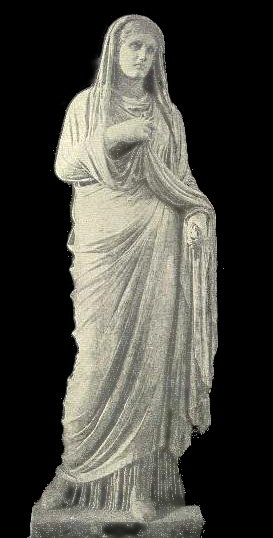
Eumachia was a Roman business entrepreneur and priestess. She served as the public priestess of Venus Pompeiana in Pompeii as well as the matron of the Fullers guild. She is known primarily from inscriptions on a large public building which she financed and dedicated to Pietas and Concordia Augusta.
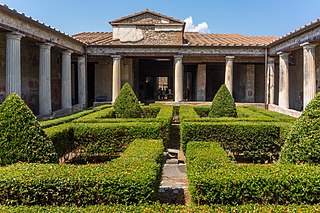
The House of Menander is one of the richest and most magnificent houses in ancient Pompeii in terms of architecture, decoration and contents, and covers a large area of about 1,800 square metres (19,000 sq ft) occupying most of its insula. Its quality means the owner must have been an aristocrat involved in politics, with great taste for art.
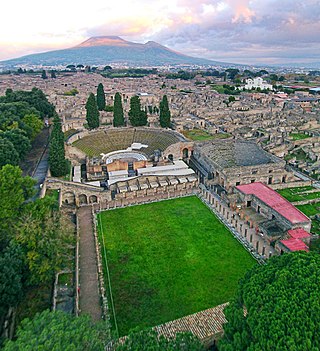
Pompeii was a city in what is now the comune (municipality) of Pompei, near Naples, in the Campania region of Italy. Along with Herculaneum, Stabiae, and many surrounding villas, the city was buried under 4 to 6 m of volcanic ash and pumice in the eruption of Mount Vesuvius in 79 AD.

Herculaneum is an ancient Roman town, located in the modern-day comune of Ercolano, Campania, Italy. Herculaneum was buried under volcanic ash and pumice in the eruption of Mount Vesuvius in 79 AD.

In archaeological terms, graffiti is a mark, image or writing scratched or engraved into a surface. There have been numerous examples found on sites of the Roman Empire, including taverns and houses, as well as on pottery of the time. In many cases the graffiti tend toward the rude, with a line etched into the basilica in Pompeii reading "Lucilla made money from her body," phallic images, as well as erotic pictures. Other graffiti took on a more innocent nature, taking the form of simple pictures or games. Although many forms of Roman graffiti are indecipherable, studying the graffiti left behind from the Roman Period can give a better understanding of the daily life and attitudes of the Roman people with conclusions drawn about how everyday Romans talked, where they spent their time, and their interactions within those spaces.
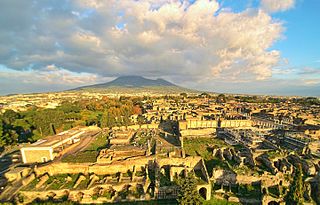
Several non-native societies had an influence on Ancient Pompeian culture. Historians’ interpretation of artefacts, preserved by the Eruption of Mount Vesuvius in 79, identify that such foreign influences came largely from Greek and Hellenistic cultures of the Eastern Mediterranean, including Egypt. Greek influences were transmitted to Pompeii via the Greek colonies in Magna Graecia, which were formed in the 8th century BC. Hellenistic influences originated from Roman commerce, and later conquest of Egypt from the 2nd century BC.
Umbricia Fortunata was a businesswoman known from the Roman city of Pompeii. She produced the popular seasoning garum, a fermented fish sauce.

The House of the Greek Epigrams is a Roman residence in the ancient town of Pompeii that was destroyed by the eruption of Mount Vesuvius in 79 CE. It is named after wall paintings with inscriptions from Greek epigrams in a small room (y) next to the peristyle.

The Stabian Baths are an ancient Roman bathing complex in Pompeii, Italy, the oldest and the largest of the 5 public baths in the city. Their original construction dates back to ca. 125 BC, making them one of the oldest bathing complexes known from the ancient world. They were remodelled and enlarged many times up to the eruption of Vesuvius in 79 AD.


















